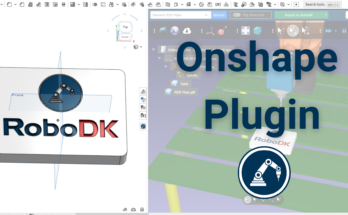Agile and flexible are two terms we often use in the context of robotics and automation… but what do they really mean?
In today’s increasingly competitive market, we are all continuously looking for new ways to stay ahead. Both agile and flexible manufacturing can be a way to achieve this competitive edge. The two terms are related, but they are not the same.
How can you improve your manufacturing business by adding agility, flexibility, or both?
Where do robots fit in an agile or flexible manufacturing process?
And what are the benefits of either approach?
Let’s compare agile manufacturing and flexible manufacturing to find out how you can apply them to make your business more competitive.

What is agile manufacturing?
Agile manufacturing is an approach that uses adaptable processes and new technologies to respond quickly and efficiently to changing market demands. An agile process will adapt to unpredictable changes, even allowing manufacturers to change their entire product lines if need be.
Agile manufacturing has shot to popularity in the last few years as businesses realized they need to keep up with the rapidly changing world conditions. There have been various challenges, including changing trade restrictions, supply chain disruptions, and labor shortages.
Those companies that responded in an agile way to such challenges are those that have come out ahead.
The key feature of an agile system is its ability to respond to unplanned and unpredictable changes. Although researchers define agility in various ways, a system’s robustness to such changes is a key factor.
When faced with an unexpected situation, an agile manufacturing system will use a combination of predetermined and innovative strategies to readjust its production.
4 benefits of agile manufacturing
There are various benefits to agile manufacturing.
These include:
- Reduced costs — Agile technologies, such as robots, can require less capital investment than more conventional mass production automation. They also need much less setup time and effort.
- Faster response time — When a completely unexpected event hits your industry, agile manufacturing allows you to change almost immediately to respond. For example, during the 2020 global pandemic, many manufacturing companies switched to manufacturing medical supplies, some in only a few weeks.
- Global scalability — Agility also allows you to respond to changing international demands and regulations. This can help your company if you are trying to grow globally.
- Reduced waste — With agile manufacturing, you only create products that are actually needed. This means you reduce the waste caused by having lots of unused “just in case” inventory.

What is flexible manufacturing?
Flexible manufacturing is a process whereby manufacturers can rapidly alter production capacity to meet planned changes in demand. For example, a flexible system can adapt to meet seasonal changes demands or fluctuations created by regular external events.
The need for flexible manufacturing has grown over the years with the increasing demand for product customization, shorter product life cycles, and more diverse customer needs. Companies now need to continually change their production processes rather than producing exactly the same products year after year, as was normal in the past.
The key feature of a flexible system is its ability to respond to planned and predictable changes. For example, perhaps you know you will always have a rush of new orders around the winter period. You can plan for this in advance by designing your manufacturing process to scale quickly following such a rush.
When faced with an expected situation, a flexible manufacturing system will seamlessly transition to meet the new production requirements using predetermined strategies.
5 benefits of flexible manufacturing
There are also various benefits to flexible manufacturing.
These include:
- Better control over processes — Flexibility puts you in the driving seat. It’s no longer stressful to react to changes in product demand or other external situations. Change becomes just a normal part of your manufacturing process.
- Continuous improvement — The key to success with flexible manufacturing is to view it as a process of continuous improvement. Whenever you experience a change in product demand or supply chain disruption, you change your system to help you better respond to similar events in the future.
- Reduced lead times — Flexible manufacturing systems can change product lines quickly. This allows you to reduce product lead times and more smoothly meet customer demand.
- Scalability — With flexible production, you can dynamically raise or lower productivity to suit current demand. This makes scalability a core part of your manufacturing process.

Agile vs flexible: Which is better?
The basic answer is… neither is better… or both are better!
In an ideal world, you can incorporate aspects of both agility and flexibility into your manufacturing operations.
With flexible manufacturing, you can “engineer to order.” This means creating products that are customized to customer needs and demands. It also allows you to gradually improve your process efficiency and product quality incrementally over time.
With agile manufacturing, you can go one step further and “innovate to order.” This means you can quickly adapt your process to create brand new products that meet customer needs on-demand. You can completely re-engineer the production process to deliver products you couldn’t have predicted, such as how Sunrob Robotics created custom hockey sticks in our case study.
Ultimately, it’s up to you to decide whether you need more agility, flexibility, or both. However, by incorporating aspects of both agile and flexible manufacturing, you can reap the full rewards of both approaches.
How robotics helps you be both agile and flexible
Adding robots is often a key tool for maximizing both agility and flexibility in manufacturing.
Many robotic systems are inherently agile, as you can easily reprogram them for new tasks. However, you need to use a robot programming software that facilitates this agility.
With software like RoboDK, you can make almost any industrial robot into a valuable tool to improve the agility and flexibility of your entire manufacturing process.
How would more agility or flexibility help you? Tell us in the comments below or join the discussion on LinkedIn, Twitter, Facebook, Instagram, or in the RoboDK Forum.. Also, check out our extensive video collection and subscribe to the RoboDK YouTube Channel




